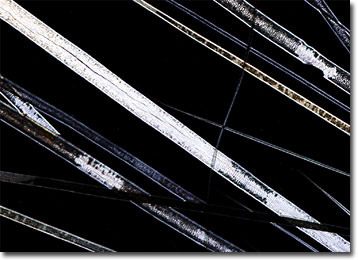Polarized Light Microscopy Digital Image Gallery
Rat Hair
Among the animals most dreaded by humans, rats rank considerably high considering their relatively diminutive size. Many varieties of rat are rather harmless, however, though all tend to suffer from the bad reputation created by a few.

True rats are rodents that belong to the Rattus genus of the family Muridae, though the term is often used in a more general way. Native to Asia, these small mammals have spread worldwide by traveling with humans. The most familiar varieties are two types of house rat, Rattus norvegicus, which is commonly called the brown or Norway rat, and Rattus rattus, better known as the black or roof rat. Of these species, the brown rat is the larger, though it is the black rat that has perhaps caused the most damage. The black rat is the species that was common during the Middle Ages in Europe and which played a central role in the spread of the devastating bubonic plague. Contrariwise, the brown rat has been extremely useful to humans in the sense that they served as the basis for the albino strain of rats used prevalently in research laboratories.
Since there are such a wide variety of species considered rats, it is rather difficult to describe their habits. Some, for instance, are highly adaptable omnivores, while others maintain specialized diets and only live in locales that meet very specific requirements. The types of dwellings they inhabit also vary significantly, ranging from burrows and nests to crevices in rocks and caves to structures built by humans. Most rats, however, are nocturnal, social, and prolific breeders. Yet, the brown rat is active in the daytime as well as the night and, though many rats live in groups, there may be a significant amount of fighting between individuals. Some rats are also good swimmers, while other are better adapted for climbing.
